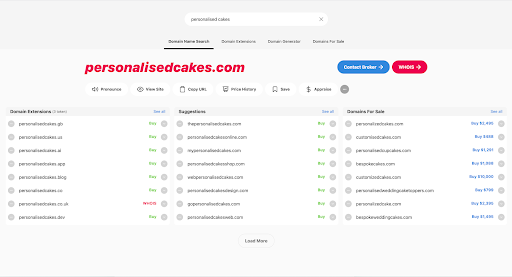Search engine optimization (SEO) is the process of making your site rank as high as possible on search engines, such as Google Search, Yahoo Search and Microsoft Bing, through keywords and user experience.
In today’s digital world, SEO should be a crucial part of even the most basic website creation, as search engines use a website’s layout, navigation, content, visuals and link popularity to rank a website on the search engine.
The closer to the top your website or web page sits on a search engine, the easier it is for people to find it. A high ranking subsequently drives organic traffic, that is, visitors who land on your website from unpaid sources. A recent survey by HubSpot found that organic search is the top source of website traffic.
So, here are six essential SEO tips to consider when building a website for your new business.
A domain name, like google.com and wikipedia.org, is a string that identifies Internet services, such as websites and email providers. They are text-based, making them easier to remember than Internet Protocol (IP) addresses, which are numerical, for example, 198.102. 434.8.
Your domain name should fit with your business and the services or products you are offering to customers. It should also be short, simple, memorable and unique.
You can use websites, such as Instant Domain Search, to check whether the domain you are thinking of is already taken online. These tools can help you pick an alternative if your desired domain name is taken. Some tools, such as Semrush’s Domain Overview, can also give you an overview of how other domains in your field perform in organic search.
Your domain name must include the primary keyword you want your website to rank high for in the search engine, as bots look at this to recognize what a web page is about and rank it. You can use an SEO tool like Moz to pick keywords for your website.
GoDaddy
Domains, Websites, Email, Hosting, Security & More. Everything You Need To Succeed Online. Your Website Starts With The Perfect Domain. Getting Online is Easy with GoDaddy. World’s Biggest Registrar.
We earn a commission if you make a purchase, at no additional cost to you.
2. Make sure your site is structured correctly
To drive traffic to your website, it’s important to prioritize an SEO-friendly structure so that both humans and search engine bots can access your information and services, and bots can gather the information needed to rank each page of your website.
Before setting up your website, use a tool such as Mural to create a site map of what pages it needs to include. For example, you will need a homepage, an about page, a contact page, and services and sub-services pages. You could also have a blog section.
You will need to choose between a hierarchical or linear website structure. Hierarchical structures, which are the most popular, follow a tree-like arrangement of categories, moving from general pages to more specific ones.
Linear structures, also known as sequential structures, are connected linearly, following a logical path of actions from the homepage.
Most well-structured websites, which enhance user experience, also have a detailed footer of important internal links so users can scroll to the bottom of the website to find anything they need easily; contact details, business address, news, events and more.
A footer is a great navigation tool for other parts of the website, and it helps the web page look neater as users know they are at the bottom.
3. Decide if you want to build the site yourself or have expert help
With the correct information, you will need to decide whether to build the website yourself, seek professional help from outside experts such as web designers and developers, or do a mix of both.
Using experts is the perfect option if you want a unique website with specific requirements. It is a collaborative process, so you get a say in the design and feel of your website, but it is also lengthy, expensive and complex.
You can hire a web designer to create a bespoke map of your website, and they will work with a web developer who will create the code to make your website run smoothly. These experts can then teach you how to manage your web pages via a content management system (CMS), such as WordPress, so you can populate the pages with your content and keep the business alive long after its launch.
If you’re inclined to build your own website, it’s crucial to select a web builder tool that not only offers the features you need but also provides robust support and user-friendly management.
Wix Website Builder
Create a website without limits. Build and scale with confidence. From a powerful website builder to advanced business solutions—we’ve got you covered.
Try Wix. No credit card required.
We earn a commission if you make a purchase, at no additional cost to you.
4. Create content before you launch
Complete the content for your homepage, and other permanent pages where the content won’t frequently change, such as the contact and about pages, prior to launching the website.
This content, like all content, should be created with keywords in mind, so make sure to conduct keyword research before you begin writing. You can use online keyword tools to find questions related to your main keyword and create content for your target audience that answers these questions.
Ahead of launching your new website, line up one month’s worth of content in advance, as no consumers want to visit an empty webpage. To keep track of this, create a content calendar which includes upcoming content topics and relevant keywords associated with those topics.
You will also want to note down any events or public holidays that may be relevant to your business so that you can address these in your content to enhance SEO. For example, a cake designer will have extra searches around the holidays (Halloween, Easter, Christmas).
It is essential to link to other websites and resources within your content to optimize SEO. However, these links must always work, or search engines will penalize your site. If you have written the content in advance, ensure the links are active before launching your site.
5. Name image files correctly
Naming your images and image files correctly is vital for SEO, as it helps search engines and users understand the content and context of your visuals.
A good file name should be easy to understand, relevant to the image, and include targeted keywords to enhance SEO further.
By incorporating keywords, you signal to search engines that your image is relevant to a particular topic or query. However, make sure to use the keywords naturally and avoid keyword stuffing.
For the image below (courtesy of Unsplash), for example, suitable alt text would read “chocolate flavor birthday cake on a glass stand,” while wrong alt text would read “cake” or “food on a plate.”

Also, it is vital to consider the alt text, or alternative text, attached to your images. Alt text is used to describe the content of an image for users who may not be able to see it, such as visually impaired users who use screen readers or those who have low-bandwidth connections.
In your alt text, which should be less than 125 characters so readers can easily digest the information, you should describe essential details of what is happening in the image. You do not need to include “image of” in the alt text, as those reading will already know the text is in the place of an image.
Again, search engines also use alt text to understand the subject matter of an image, which can help improve your image’s SEO ranking, so include keywords but don’t stuff it.
$10K Verizon Grants and Other Free Benefits for Entrepreneurs
6. Stay up to date on SEO techniques and best practices
Read and follow blogs from industry experts
Subscribing to one or more SEO blogs, such as Search Engine Journal, is the best way to get updates about the industry, trending topics, best practices, new techniques and more.
Google is the top search engine, with over 85% of the market share, so you will want your website to rank highly on Google as that’s where most consumers are. So we recommend also subscribing to the Google Search Central Blog.
There are also SEO industry gurus, such as Areej AbuAli and AJ Ghergich, who use personal blogs and social media accounts to share opinions and advice.
Read and follow industry news
Subscribe to the news feed of some of the leading news sites and magazines in the SEO industry, but only subscribe to a select number of sources as this becomes overwhelming and may lead to you receiving misinformation.
Listen to podcasts or watch YouTube videos
Podcasts, such as Rankable Podcast, are the latest means to keep yourself informed about your favorite subjects on the go, and they have advantages, as listening to an SEO expert is more effective than reading the same content.
If listening to SEO podcasts is fun, you can also learn from watching videos on YouTube, the second largest search engine.
Join online forums and like-minded community groups
SEO professionals and experts are very active on the likes of Reddit and Quora, so consider joining some of the most active groups on these forums and communities.
You can participate in discussions, ask questions, share your opinions, and learn from people who know SEO firsthand.
Closing thoughts
It is not only crucial in today’s digital world to set up a website to accompany any products or services you may be offering, but it’s also important for your website to rank highly on search engines so people can find your business with a single keyword search.
Using these six SEO tips and keeping up-to-date with SEO best practices will optimize the organic traffic coming to your website and therefore, make a profit for your business.
Subscribe to The Start, the Newsletter Built for Entrepreneurs
The post originally appeared on following source : Source link





